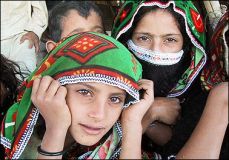FEATURE-People in east Sudan eke out life on trickle of aid
By Ed Harris
HOR-MILIH, Sudan, June 12 (Reuters) – Barefoot men in grubby white tunics, with wild eyes and unkempt hair, gather round a hole in a dried-up riverbed, lowering skins and dirty plastic buckets by rope in search of water far below.

|
|
Children from the nomadic tribe of the Rashaidas from eastern Sudan they wait on a roadside with their parents for people to come buy their smuggled goods in Tesseney, western Eritrea. (AFP). |
The Beja people live a virtually medieval existence among desert plains and stony mountains in remote and rebel-controlled eastern Sudan.
Lack of development in their region is one of the main grievances that spur the Beja rebels who have controlled this small area on the Eritrean border since early 1997.
The same kind of local resentment towards the distant government in Khartoum has been a key factor behind other Sudanese conflicts, in western Darfur region and the south.
When aid workers first arrived in the east in 2000, they were shocked.
“We found a humanitarian situation that was probably one of the worst we had ever seen in Africa,” Fergus Thomas, field coordinator for the U.S.-based International Rescue Committee (IRC), said at its base in Hor-Milih in northeast Sudan.
“We found a population with rampant epidemics, with no health structure in place, with no education system, and illiteracy rates of more than 97 percent,” he told Reuters, adding that fighting had exacerbated the situation.
Despite the entry of aid groups, there are fears that resentment in the east of Sudan towards Khartoum could make it the next flashpoint in Africa’s largest country.
Conflict in Sudan’s western Darfur region — where rebels have similar complaints of being marginalised by Khartoum — shocked the world over the past two years. A two-decade-old war in the south was only resolved by a peace deal in January.
ECHOES OF DARFUR
The eastern region has been relatively quiet since 2002, but now rebels are threatening to step up activity.
The front lines are littered with mines and checkpoints, reducing the scope for grazing animals and the opportunities for work in the towns of Port Sudan and Kassala.
Even the landscape can be hostile. Charities working here burn up aid money in petrol and vehicle maintenance just trying to get from one place to another along rough tracks that can be little more than imprints in the sand, or even a driver’s memory.
Ali Talab is a member of the governing committee for Hamesh Koreb, a sprawl of mud buildings and the largest town in the area. He said the Beja were fighting for the rights they had been denied since Sudan’s independence from Britain.
“They (the government) have provided us with nothing since 1956,” he said.
An estimated 2.4 million Beja — a traditionally nomadic group — live in Sudan, aid workers say, with another 400,000 in neighbouring Egypt and Eritrea. Beja representatives, however, put the number closer to four million.
Independent estimates of the number of Beja living in the relatively small rebel-controlled area of approximately 15,000 sq km (5,800 sq mile) vary between 45,000 and 186,000.
“With a population that is coming and going, it is very hard to tell,” Thomas said.
Conditions in the rebel territory appear to have eased slightly in recent years as two aid groups — the IRC and U.S.-based Samaritan’s Purse — supply medicines and food.
Some Beja people are reported to be crossing back into the rebel-held area, where access to aid is perceived to be better than in adjacent government regions, aid workers said.
But that is hardly saying much.
In Maman Sharum village, an old man in a pair of dirty trousers lies outside the health clinic on a bed of wood and rope, sick with skin disease and coughing.
“Just look at this guy, and tell us if Khartoum is good or bad,” says Anur Ahmed, who helped to build the clinic.
Statistics from 2001 show rates of chronic malnutrition among children under five were estimated at 27 percent in the area while 25 percent were borderline cases, say aid groups.
MORE FOOD
A food aid programme began last year.
“Statistics don’t show much change (in the rates of malnutrition), but food has become much more available,” said Thomas, who estimated IRC health services, including vaccinations and curative care, now reach 75 percent of people.
Female genital mutilation is universal and women eat little during pregnancy in the belief that smaller babies make giving birth easier. A 2001 estimate linked 40 percent of deaths among 16-45 year old women to childbirth, say aid workers.
By day, men and women lead separate lives, and the women are covered from head to toe. Men may visit the women’s tents at night, but they must leave before morning.
There are some improvements in education trickling through.
In Hashanet West village, a young man with three traditional ritual scars down each cheek is teaching about 30 boys to read in their native Bedawit language.
Adam Hassan uses a chalkboard and books produced with the help of the IRC to instruct his pupils.
The books are the first to be published in the native Bedawit language for thousands of years and Hassan explains their elementary importance to preserving his culture.
“It’s my mother language.”
